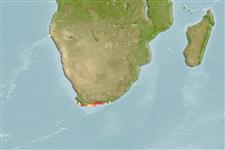>
Blenniiformes (Blennies) >
Clinidae (Clinids)
Etymology: Pavoclinus: Latin, pavo = peacock + Greek, klino, klinein = to incline (Ref. 45335).
Environment: milieu / climate zone / depth range / distribution range
Écologie
marin démersal; profondeur 18 - 22 m (Ref. 5496). Subtropical
Southeast Atlantic: known from one collection taken off the mouth of the Storms River, South Africa.
Taille / Poids / Âge
Maturity: Lm ? range ? - ? cm
Max length : 5.5 cm TL mâle / non sexé; (Ref. 5496)
Description synthétique
Clés d'identification | Morphologie | Morphométrie
Épines dorsales (Total) : 36 - 38; Rayons mous dorsaux (Total) : 2 - 3; Épines anales: 2; Rayons mous anaux: 25 - 27. Head and body with large, irregular, white-edged blotches of russet brown; fins hyaline; anterior part of dorsal fin yellowish brown (Ref. 5496).
Collected over gravel (Ref. 28111).
Life cycle and mating behavior
Maturities | Reproduction | Spawnings | Egg(s) | Fecundities | Larves
Smith, M.M., 1986. Clinidae. p. 758-769. In M.M. Smith and P.C. Heemstra (eds.) Smiths' sea fishes. Springer-Verlag, Berlin. (Ref. 5496)
Statut dans la liste rouge de l'IUCN (Ref. 130435)
Menace pour l'homme
Harmless
Utilisations par l'homme
Outils
Articles particuliers
Télécharger en XML
Sources Internet
Estimates based on models
Preferred temperature (Ref.
123201): 15.8 - 19.6, mean 18.6 °C (based on 6 cells).
Phylogenetic diversity index (Ref.
82804): PD
50 = 0.5020 [Uniqueness, from 0.5 = low to 2.0 = high].
Bayesian length-weight: a=0.00513 (0.00223 - 0.01182), b=3.06 (2.86 - 3.26), in cm total length, based on LWR estimates for this (Sub)family-body shape (Ref.
93245).
Niveau trophique (Ref.
69278): 3.2 ±0.0 se; based on diet studies.
Résilience (Ref.
120179): Haut, temps minimum de doublement de population inférieur à 15 mois (Preliminary K or Fecundity.).
Fishing Vulnerability (Ref.
59153): Low vulnerability (10 of 100).
